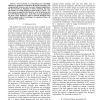Free Online Productivity Tools
i2Speak
i2Symbol
i2OCR
iTex2Img
iWeb2Print
iWeb2Shot
i2Type
iPdf2Split
iPdf2Merge
i2Bopomofo
i2Arabic
i2Style
i2Image
i2PDF
iLatex2Rtf
Sci2ools
TSMC
2008
2008
Selection of DNA Markers
Given a genome, i.e., a long string over a fixed finite alphabet, the problem is to find short (dis)similar substrings. This computationally intensive task has many biological applications. We first describe an algorithm to detect substrings that have edit distance to a fixed substring at most equal to a given e. We then propose an algorithm that finds the set of all substrings that have edit distance larger than e to all others. Several applications are given, where attention is paid to practical biological issues such as hairpins and GC percentage. An experiment shows the potential of the methods.
| Added | 15 Dec 2010 |
| Updated | 15 Dec 2010 |
| Type | Journal |
| Year | 2008 |
| Where | TSMC |
| Authors | Hendrik Jan Hoogeboom, Walter A. Kosters, Jeroen F. J. Laros |
Comments (0)

